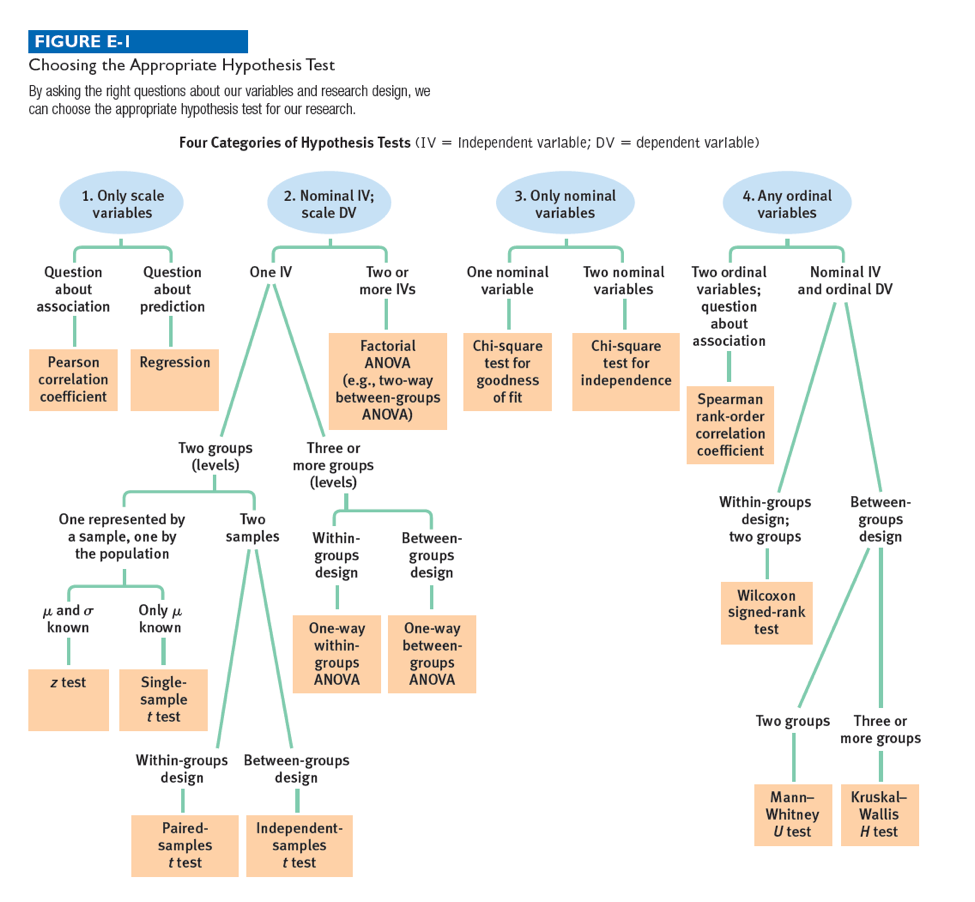Chapter 15. Tinder and Online Dating: Everything Up to the Pearson Correlation Coefficient
Introduction
By Warren Fass, University of Pittsburgh Bradford, and Susan A. Nolan, Seton Hall University
Basu, T. (2016, March 25). Lessons from Tinder’s in-house love doctor. Opens in new window https://psmag.com/social-justice/odds-are-you-got-on-tinder-to-find-true-love
Smith, A. (2016, February 11). 15% of American adults have used online dating sites or mobile dating apps. Opens in new window https://www.pewinternet.org/2016/02/11/15-percent-of-american-adults-have-used-online-dating-sites-or-mobile-dating-apps/
Introduction

In this activity, we will consider various findings from the Pacific Standard article, “Lessons From Tinder’s In-House Love Doctor” (Basu, 2016). Then you will identify statistical analyses that could be used to support the various conclusions.

Choosing the Appropriate Hypothesis Test, Image Long Description
By asking the right questions about our variables and research design, we can choose the appropriate hypothesis test for our research.
Four Categories of Hypothesis Tests (IV = Independent variable; DV = dependent variable)
Example 1 of 4


Have you ever used an online dating site such as eHarmony, Match.com, or Tinder? According to the results from a survey conducted by the Pew Research Center (Smith, 2016), “15% of American adults have used either online dating sites or mobile dating apps.” One popular dating site, Tinder, is estimated to have over 50 million users. Jessica Carbino was one of those users, while earning her Ph.D. in sociology at UCLA. In fact, one of her Tinder dates was with Sea Rad, the founder of Tinder. The romantic relationship didn’t go anywhere, but as a result of that date, Jessica (now Dr. Carbino) was hired to work at Tinder as an online dating sociologist. In 2016, Dr. Carbino was interviewed by Tanya Basu, who writes for Pacific Standard magazine (Basu, 2016), to answer questions related to her research on facial attractiveness in online dating. What were some of her findings?
Example 1 of 4

When looking at profile pictures on Tinder, can facial features tell us about personality characteristics? According to Dr. Carbino, “people are actually able to analyze a photo or snapshot of somebody, whether in person or not in person, and gauge a great deal of information about the person with a lot of accuracy, very fast.” In other words, the judgments occur based upon a small amount of information. Dr. Carbino stated that “women may associate a harder jawline with more brash, more narcissistic tendencies.” Dr. Carbino did not outline the evidence for this theory, but we can design a study to see if there is a relation between jawline and narcissistic tendencies. Suppose we recruit 20 women to participate in the study. The women would be shown a man’s profile picture. The women would be asked to rate the picture according to two different scales. The women would be asked to rate the degree of narcissism (1 = little, if any, 10 = a lot) depicted in that profile picture. The women would also be asked to rate the quality of the jawline of the profile picture (1 = soft, 10 = hard). We would then have two ratings from each woman.
Example 1 of 4
Which statistical test could be used to determine if there was a relation between the two variables – degree of narcissism and quality of jawline?
Now you can skip ahead to the next example by clicking here. Or, if you would like more practice walking through the flowchart questions, then simply click the Next button in the bottom right corner of the screen.
Example 1 of 4
In which of the following four categories does this situation fall? Click to see the data again. And click on the flowchart button to see the overview for choosing the best test.
Example 1 of 4
Is the research question about association or prediction?
Example 1 of 4
Based on the answers to these questions, which statistical test could be used to determine if there was a relationship between the two variables, degree of narcissism and quality of jawline?
Example 2 of 4

Now let’s look at another finding from Dr. Carbino’s research (Basu, 2016). Dr. Carbino found that a majority of Tinder users wear neutral colors (e.g., white, gray, black) in their photos. Dr. Carbino found that surprising because she expected individuals would wear colors to make them stand out in their photos, perhaps to appear more attractive. Imagine that we recruited 30 adult men, and randomly assigned them to one of three groups—the first group would be shown a picture of an adult woman dressed in a gray outfit, the second group would be shown a picture of an adult woman dressed in a red outfit, and the third group would be shown a picture of an adult woman wearing a green outfit. (The adult woman would be the same person in the three different pictures with the exception of the color of her outfit). After viewing their respective picture, the participants were asked to rate the attractiveness (1 = not very, 10 = very) of the person in the picture.
Example 2 of 4
What statistical analysis could be used to determine whether there was a significant difference among the three groups’ ratings?
Now you can skip ahead to the next example by clicking here. Or, if you would like more practice walking through the flowchart questions, then simply click the Next button in the bottom right corner of the screen.
Example 2 of 4
In which of the following four categories does this situation fall? Click to see the data again. And click on the flowchart button to see the overview for choosing the best test.
Imagine that we recruited 30 adult men, and randomly assigned them to one of three groups—the first group would be shown a picture of an adult woman dressed in a gray outfit, the second group would be shown a picture of an adult woman dressed in a red outfit, and the third group would be shown a picture of an adult woman wearing a green outfit. (The adult woman would be the same person in the three different pictures with the exception of the color of her outfit). After viewing their respective picture, the participants were asked to rate the attractiveness (1 = not very, 10 = very) of the person in the picture.
Example 2 of 4
How many nominal independent variables are there?
Example 2 of 4
How many levels does the independent variable have?
Example 2 of 4
What type of design is this?
Example 2 of 4
Based on the answers to these questions, what statistical analysis could be used to determine whether there was a significant difference among the ratings from the three groups?
Example 3 of 4
Dr. Carbino stated that one of the benefits of using Tinder is that people must provide a brief bio with their profile picture (Basu, 2016). The brief bio, according to Dr. Carbino, would contain more information about a prospective date, than if you met a person at a bar. Imagine that we recruit a group of 20 men and randomly assign one half of the group to view a profile picture of a woman with her brief bio, and the remaining one half of the group would view the same profile picture without the brief bio. After viewing their respective profile pictures, all of the men were asked to rate the likelihood (1 = not likely, 5 = very likely) they would date the woman in the picture.
What statistical analysis could be used to determine whether there was a significant difference between the likelihood ratings from the two groups?
Now you can skip ahead to the next example by clicking here. Or, if you would like more practice walking through the flowchart questions, then simply click the Next button in the bottom right corner of the screen.
Example 3 of 4
In which of the following four categories does this situation fall? Click to see the data again. And click on the flowchart button to see the overview for choosing the best test.
Imagine that we recruit a group of 20 men and randomly assign one half of the group to view a profile picture of a woman with her brief bio, and the remaining one half of the group would view the same profile picture without the brief bio. After viewing their respective profile pictures, all of the men were asked to rate the likelihood (1 = not likely, 5 = very likely) they would date the woman in the picture.
Example 3 of 4
How many nominal independent variables are there?
Example 3 of 4
How many levels does the independent variable have?
Example 3 of 4
How many samples are there?
Example 3 of 4
What type of design is this?
Example 3 of 4
Based on the answers to these questions, what statistical test could be used to determine whether there was a significant difference between the likelihood ratings from the two groups?
Example 4 of 4
Let’s look at one last point from Dr. Carbino’s interview, the belief that Tinder is only used “as a hook-up generator.” Although Dr. Carbino did not compare the use of Tinder to other dating sites, imagine that we conduct the following study. We recruit 20 men, and provide each man only the names of two dating sites: Tinder and Match.com. We ask the men to rate both sites with respect to their agreement (1 = disagree, 5 = agree) about whether that site is used primarily as a hook-up site.
What statistical analysis could be used to determine whether there was a significant difference between the men’s ratings of the two dating sites?
Now you can skip ahead to the end of the activity by clicking here. Or, if you would like more practice walking through the flowchart questions, then simply click the Next button in the bottom right corner of the screen.
Example 4 of 4
In which of the following four categories does this situation fall? Click to see the data again. And click on the flowchart button to see the overview for choosing the best test.
Let’s look at one last point from Dr. Carbino’s interview, the belief that Tinder is only used “as a hook-up generator.” Although Dr. Carbino did not compare the use of Tinder to other dating sites, imagine that we conduct the following study. We recruit 20 men, and provide each man only the names of two dating sites: Tinder and Match.com. We ask the men to rate both sites with respect to their agreement (1 = disagree, 5 = agree) about whether that site is used primarily as a hook-up site.
Example 4 of 4
How many nominal independent variables are there?
Example 4 of 4
How many levels does the independent variable have?
Example 4 of 4
How many samples are there?
Example 4 of 4
What type of design is this?
Example 4 of 4
Based on the answers to these questions, what statistical test could be used to determine whether there was a significant difference between the likelihood ratings from the two groups?
15.1 Activity Completed!

Congratulations! You have completed the activity and gained some good experience in choosing the best hypothesis test.